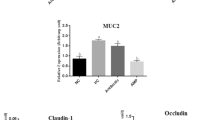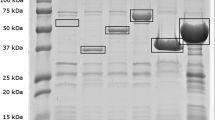Abstract
Antimicrobial resistance is a significant challenge for human and animal health, and developing effective antibiotic-free treatments is a strategy to help mitigate microbial resistance. The global poultry industry faces growing challenges from Eimeria-induced coccidiosis, a serious enteric disease of chickens that currently requires treatment using ionophore antibiotics. Eimeria stimulates interleukin-10 (IL-10) expression in the small intestine and caecum of infected chickens, suppressing their immune response and facilitating disease progression. Single-domain antibodies raised from llamas immunized with chicken IL-10 (cIL-10) were developed that bind cIL-10 in vitro, block cIL-10 receptor binding and induce interferon gamma (IFN-γ) secretion from cIL-10-repressed primary chicken splenocytes. Single-domain antibodies expressed in transgenic corn demonstrated significant accumulation in phenotypically normal plants. When fed to Eimeria-challenged chickens, the transgenic corn significantly improved body weight gain (equal to that of salinomycin-treated animals), normalized the feed conversion ratio (to the same level as uninfected control animals), lowered E. tenella lesion scores to those of salinomycin-treated control animals, and reduced oocyst counts below those of infected untreated control animals. Here, we propose that transgenic corn may have a role in reducing the use of antibiotics in poultry production and maintaining animal health and productivity, and may contribute to efforts against global antimicrobial resistance.
This is a preview of subscription content, access via your institution
Access options
Access Nature and 54 other Nature Portfolio journals
Get Nature+, our best-value online-access subscription
$29.99 / 30 days
cancel any time
Subscribe to this journal
Receive 12 digital issues and online access to articles
$119.00 per year
only $9.92 per issue
Buy this article
- Purchase on Springer Link
- Instant access to full article PDF
Prices may be subject to local taxes which are calculated during checkout





Similar content being viewed by others
Data availability
Source data for Figs. 1, 3 and 5 are provided with the paper. Data from these studies are available through Figshare (www.figshare.com) at https://doi.org/10.6084/m9.figshare.10286153.v1.
References
Livestock and Poultry: World Markets and Trade (USDA, 2019); https://usda.library.cornell.edu/concern/publications/73666448x
Ritchie, H. & Roser, M. Meat and Seafood Production & Consumption (Our World In Data, accessed 2017); https://ourworldindata.org/meat-and-seafood-production-consumption
Eshel, G., Shepon, A., Makov, T. & Milo, R. Land, irrigation water, greenhouse gas, and reactive nitrogen burdens of meat, eggs, and dairy production in the United States. Proc. Natl Acad. Sci. USA 111, 11996–12001 (2014).
Laurent, F., Mancassola, R., Lacroix, S., Menezes, R. & Naciri, M. Analysis of chicken mucosal immune response to Eimeria tenella and Eimeria maxima infection by quantitative reverse transcription-PCR. Infect. Immun. 69, 2527–2534 (2001).
Jones, P. J., Niemi, J., Christensen, J.-P., Tranter, R. B. & Bennett, R. M. A review of the financial impact of production diseases in poultry production systems. Anim. Prod. Sci. 59, 1585–1597 (2018).
Dalloul, R. A. & Lillehoj, H. S. Poultry coccidiosis: recent advancements in control measures and vaccine development. Expert Rev. Vaccines 5, 143–163 (2006).
Noack, S., Chapman, H. D. & Selzer, P. M. Anticoccidial drugs of the livestock industry. Parasitol. Res. 118, 2009–2026 (2019).
Tensa, L. R. & Jordan, B. J. Comparison of the application parameters of coccidia vaccines by gel and spray. Poult. Sci. 98, 634–641 (2019).
Price, K. R., Hafeez, M. A., Bulfon, J. & Barta, J. R. Live Eimeria vaccination success in the face of artificial non-uniform vaccine administration in conventionally reared pullets. Avian Pathol. 45, 82–93 (2016).
Blake, D. P. & Tomley, F. M. Securing poultry production from the ever-present Eimeria challenge. Trends Parasitol. 30, 12–19 (2014).
Hermans, P. G., Fradkin, D., Muchnik, I. B. & Morgan, K. L. Prevalence of wet litter and the associated risk factors in broiler flocks in the United Kingdom. Vet. Rec. 158, 615–622 (2006).
Fatoba, A. J. & Adeleke, M. A. Diagnosis and control of chicken coccidiosis: a recent update. J. Parasit. Dis. 42, 483–493 (2018).
Arendt, M. K., Sand, J. M., Marcone, T. M. & Cook, M. E. Interleukin-10 neutralizing antibody for detection of intestinal luminal levels and as a dietary additive in Eimeria challenged broiler chicks. Poult. Sci. 95, 430–438 (2016).
Hong, Y. H., Lillehoj, H. S., Lillehoj, E. P. & Lee, S. H. Changes in immune-related gene expression and intestinal lymphocyte subpopulations following Eimeria maxima infection of chickens. Vet. Immunol. Immunopathol. 114, 259–272 (2006).
Rothwell, L. et al. Cloning and characterization of chicken IL-10 and its role in the immune response to Eimeria maxima. J Immunol. 173, 2675–2682 (2004).
Wu, Z. et al. Analysis of the function of IL-10 in chickens using specific neutralising antibodies and a sensitive capture ELISA. Dev. Comp. Immunol. 63, 206–212 (2016).
Sand, J. M., Arendt, M. K., Repasy, A., Deniz, G. & Cook, M. E. Oral antibody to interleukin-10 reduces growth rate depression due to Eimeria spp. infection in broiler chickens. Poult. Sci. 95, 439–446 (2016).
He, Z., Tong, C., Sheng, L., Ma, M. & Cai, Z. Monitoring glycation-induced structural and biofunctional changes in chicken immunoglobulin Y by different monosaccharides. Poult. Sci. 95, 2715–2723 (2016).
Mizukami, M. et al. Highly efficient production of VHH antibody fragments in Brevibacillus choshinensis expression system. Protein Expr. Purif. 105, 23–32 (2015).
Egelkrout, E. et al. Enhanced expression levels of cellulase enzymes using multiple transcription units. BioEnergy Res. 6, 699–710 (2012).
Tschofen, M., Knopp, D., Hood, E. & Stöger, E. Plant molecular farming: much more than medicines. Annu. Rev. Anal. Chem. 9, 271–294 (2016).
Pardon, E. et al. A general protocol for the generation of Nanobodies for structural biology. Nat. Protoc. 9, 674–693 (2014).
Zdanov, A. et al. Crystal structure of interleukin-10 reveals the functional dimer with an unexpected topological similarity to interferon γ. Structure 3, 591–601 (1995).
Terai, M. et al. Human interleukin 10 receptor 1/IgG1-Fc fusion proteins: Immunoadhesins for human IL-10 with therapeutic potential. Cancer Immunol. Immunother. 58, 1307–1317 (2009).
Shouval, D. S. et al. Interleukin 10 receptor signaling: master regulator of intestinal mucosal homeostasis in mice and humans. Adv. Immunol. 122, 177–210 (2014).
Negrotto, D., Jolley, M., Beer, S., Wenck, A. R. & Hansen, G. The use of phosphomannose isomerase as a selectable marker to recover transgenic maize plants (Zea mays L.) via Agrobacterium transformation. Plant Cell Rep. 19, 798–803 (2000).
Reina, M., Guillén, P., Ponte, I., Boronat, A. & Palau, J. DNA sequence of the gene encoding the Zc1 protein from Zea mays W64 A. Nucleic Acids Res. 18, 6425 (1990).
Qu, L. Q. & Takaiwa, F. Evaluation of tissue specificity and expression strength of rice seed component gene promoters in transgenic rice. Plant Biotechnol. J. 2, 113–125 (2004).
Prat, S., Cortadas, J., Puigdomrnech, P. & Palau, J. Nucleic acid (cDNA) and amino acid sequences of the maize endosperm protein glutelin-2. Nucleic Acids Res. 13, 1493–1504 (1985).
Semenza, J. C., Hardwick, K. G., Dean, N. & Pelham, H. R. B. ERD2, a yeast gene required for the receptor-mediated retrieval of luminal ER proteins from the secretory pathway. Cell 61, 1349–1357 (1990).
Broiler Performance and Nutrition Supplement (Cobb-Vantress, 2015).
Angelakis, E. Weight gain by gut microbiota manipulation in productive animals. Microb. Pathog. 106, 162–170 (2017).
Ben Lagha, A., Haas, B., Gottschalk, M. & Grenier, D. Antimicrobial potential of bacteriocins in poultry and swine production. Vet. Res. 48, 1–12 (2017).
Roth, N. et al. The application of antibiotics in broiler production and the resulting antibiotic resistance in Escherichia coli: a global overview. Poult. Sci. 98, 1791–1804 (2019).
Kadykalo, S. et al. The value of anticoccidials for sustainable global poultry production. Int. J. Antimicrob. Agents 51, 304–310 (2018).
Mathis, G. et al. Effect of lasalocid or salinomycin administration on performance and immunity following coccidia vaccination of commercial broilers 1. J. Appl. Poult. Res. 23, 577–585 (2014).
Lillehoj, H. S. et al. A recombinant Eimeria protein inducing interferon-γ production: comparison of different gene expression systems and immunization strategies for vaccination against coccidiosis. Avian Dis. 44, 379–389 (2017).
Yusibov, V., Kushnir, N. & Streatfield, S. J. Antibody production in plants and green algae. Annu. Rev. Plant Biol. 67, 669–701 (2016).
Wang, S. et al. Increasing stability of antibody via antibody engineering: stability engineering on an anti-hVEGF. Proteins 82, 2620–2630 (2014).
Kusnadi, A. R., Nikolov, Z. L. & Howard, J. A. Production of recombinant proteins in transgenic plants: practical considerations. Biotechnol. Bioeng. 56, 473–484 (1997).
Smith, M. D. & Glick, B. R. The production of antibodies in plants: an idea whose time has come? Biotechnol. Adv. 18, 85–89 (2000).
Lee, Y., Kim, W. H., Lee, S. J. & Lillehoj, H. S. Detection of chicken interleukin-10 production in intestinal epithelial cells and necrotic enteritis induced by Clostridium perfringens using capture ELISA. Vet. Immunol. Immunopathol. 204, 52–58 (2018).
Zhang, R. et al. Mutual interactions of the apicomplexan parasites Toxoplasma gondii and Eimeria tenella with cultured poultry macrophages. Parasites Vectors 11, 1–12 (2018).
Virdi, V. et al. Yeast-secreted, dried and food-admixed monomeric IgA prevents gastrointestinal infection in a piglet model. Nat. Biotechnol. 37, 527–530 (2019).
Josephson, K. et al. Design and analysis of an engineered human interleukin-10 monomer. J. Biol. Chem. 275, 13552–13557 (2000).
Komari, T., Hiei, Y., Saito, Y., Murai, N. & Kumashiro, T. Vectors carrying two separate T-DNAs for co-transformation of higher plants mediated by Agrobacterium tumefaciens and segregation of transformants free from selection markers. Plant J. 10, 165–174 (1996).
Ishida, Y., Saito, H., Ohta, S., Hiei, Y. & Komari, T. High efficiency transformation of maize (Zea mays L.) mediated by Agrobacterium tumefaciens. Nature 14, 745–750 (1996).
Abdelrahman, W. et al. Comparative evaluation of probiotic and salinomycin effects on performance and coccidiosis control in broiler chickens. Poult. Sci. 93, 3002–3008 (2014).
Acknowledgements
We acknowledge the contributions of the following scientists: A. Lee (ProSci); K. Wilhelmsen (Marin Biologic); L. Bartlett (University of Massachusetts Biophysical Characterization Facility); B. Lumpkins and G. Mathis (Southern Poultry Feed and Research).
Author information
Authors and Affiliations
Contributions
P.A.L. led the antibody discovery programme, led the cell-based assay development and performance, managed analytical development, helped transplant, water and harvest plants, milled transgenic grain for use in the feeding studies, and reviewed and edited the manuscript. M.P. characterized the antibodies in vitro and in the cell-based assay, which required microbial antibody and IL-10r soluble-domain production, performed Biacore experiments, performed western blots and reviewed the manuscript. O.B. conducted all gene design and synthesis, constructed transformation vectors, helped genotype transgenic plants, developed the ELISA assay, performed ELISAs, measured the thermal stability of the antibodies, and reviewed and edited the manuscript. B.S. conducted western blot analysis, helped develop the ELISA assay, performed ELISAs and reviewed the manuscript. V.S. conducted plant transformation and plant tissue culture, generated all transgenic events, managed and conducted plant production, and reviewed the manuscript. J.B. led the animal challenge studies and reviewed the manuscript. X.L. helped transplant, water and harvest plants, conducted assays, and reviewed and edited the manuscript. R.M.R. developed the overall research plan and strategy, managed and coordinated studies between groups, prioritized antibodies for development, helped transplant, water and harvest plants, drafted the initial paper, and reviewed and approved the final manuscript.
Corresponding author
Ethics declarations
Competing interests
The authors declare the following competing interests: employment at Agrivida, Inc.
Additional information
Publisher’s note Springer Nature remains neutral with regard to jurisdictional claims in published maps and institutional affiliations.
Supplementary information
Supplementary Information
Supplementary Figs. 1 and 2.
Source data
Source Data Fig. 1
Numerical data for the graphs.
Source Data Fig. 3
Numerical data for the graphs.
Source Data Fig. 5
Numerical data for the graphs.
Rights and permissions
About this article
Cite this article
Lessard, P.A., Parker, M., Bougri, O. et al. Improved performance of Eimeria-infected chickens fed corn expressing a single-domain antibody against interleukin-10. Nat Food 1, 119–126 (2020). https://doi.org/10.1038/s43016-020-0029-6
Received:
Accepted:
Published:
Issue Date:
DOI: https://doi.org/10.1038/s43016-020-0029-6
This article is cited by
-
Putting antimicrobial resistance in the corner
Nature Food (2020)



